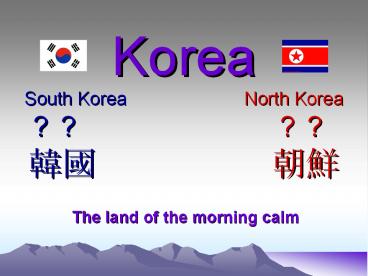Korea South Korea North Korea - PowerPoint PPT Presentation
1 / 20
Title:
Korea South Korea North Korea
Description:
South Korea: 48,846,823. North Korea: 23,113,019. Climate: Temperate: ... Hangul only newspapers in South Korea first published in 1988. National Creation Myth: ... – PowerPoint PPT presentation
Number of Views:4619
Avg rating:3.0/5.0
Title: Korea South Korea North Korea
1
KoreaSouth Korea North
Korea?? ????
??
- The land of the morning calm
2
Geopolitical Location
Manchuria
- Appendage to China
- Dagger pointed at the heart of Japan
3
Geography
- Overall Shape?
- What do you see?
- Size
- Roughly equal to Utah
- Population in 06
- South Korea 48,846,823
- North Korea 23,113,019
- Climate
- Temperate
- Cold winters
- Hot, wet summers
- Topography
- Mountainous
4
Divided Nation
- Japanese Occupation 1910
- Divided in 1945
- Carrot used by US to lure USSR into the Pacific
phase of WWII - 38th Parallel
- North Soviet realm ergo Communist
- South US realm ergo Capitalist
- Korean War 1950-53
- Enemies
- Divided Families
- No mail, no trade, no visits, no phone calls
5
Ethnic Homogeneity
- Racially pure, Unique Race
- East Asian or Mongoloid racial group
- Strong sense of racial identity
- Self-identification as distinct from other Asian
nations
6
Korean Language???
???
- Altaic Language Group
- Structurally identical to Japanese
- 60 of vocabulary borrowed from Chinese
- Distinct from both
- Not a tonal language
- Regional dialects Just like U.S.
7
Korean Language???
???
- Early Literacy Chinese
- Early Writing Chinese Characters
- 1400s Hangul commissioned by King Sejong
- Phonetic system
- Simple enough for women servants
8
(No Transcript)
9
Writing System
- Mixed Writing system
- Chinese root words written in Chinese characters
- 900 characters to pass middle school
- 1800 characters to pass high school
- Korean Native words written in Hangul
- Typical until 1945
- North Korea dropped Chinese about 1950
- Hangul only newspapers in South Korea first
published in 1988
10
National Creation Myth Tangun 2333 BC
- Hwan-ung (god figure)
- Tiger and Bear want to be human
- Live in cave 100 days eating mugwort and garlic
- Bear endures and becomes a woman
- She prays for a husband
- Hwan-ung takes her as wife and they bear a son,
Tangun who governs over the people of Korea
See http//www.lifeinkorea.com/information/tangun.
cfm for a simple but solid version of this story
on the web.
11
Native Religious Traditions
- Animistic religious beliefs
- Shamanism
- Mudang
- Korean Shaman
- Always Female
- Kut
- Korean exorcism
- Ecstatic dance
12
Native Spiritual / Cultural Concepts
- Han
- Collective burden of historic pain
- Centuries of oppression
- Eons of suffering
- Creates a sorrow, sense of blues that is unique
to Koreans and pervades their art, music and
culture
13
Native Spiritual Concepts
- Nature of the Human Soul
- Similar to China spirit resides in the
environment of its life/death. - Burial practices similar to China
14
Native Spiritual Concepts
- Ancestor Veneration
- Chesa
- Enhanced formalized by Confucianism
- Major part of civil responsibility in later
Korean history
15
Borrowed Religious Concepts
- Daoism
- Focus on nature
- Fengshui
- Confucianism
- Buddhism
- Christianity arrives late
16
Daoist ideasSymbolism of the South Korean Flag
- Center is the Korean version of the Yin-Yang
symbol - The four trigrams are
- ? geon (? ?) heaven ?
- ? gon (? ?) earth ?
- ? ri (? ?) sun ?
- ? gam (? ?) moon ?
17
Fengshui (Chinese)Pungsu (Korean)
- Geomancy
- Wind and Water
- Used in
- Interior decorating
- Architecture
- City planning, etc.
- 5 Frog Brothers Folk tale
18
Confucianism
- Borrowed from China
- Dominant Governing Ideology
- in later dynasties
- Major impact on Korean Culture
- Hierarchy
- Ritualism and formality
- Male dominance
19
Buddhism
- Borrowed from China
- About 50 CE
- Becomes important about 500 CE
- Adopted by early dynasties
- Political dominance early on
- Coexists with Confucianism, Daoism and native
traditions -- usually
20
Christianity
- Catholics enter 1774
- Protestants enter 1884
- Both become politically and socially very
important - Protestants 1900 to the present
- Catholics briefly about 1800 and again since
1970 - (much more to come in later history discussion)
Myongdong Cathedral Seoul































